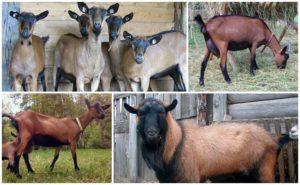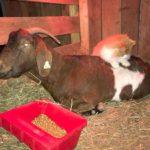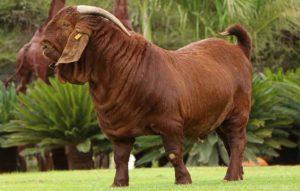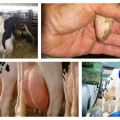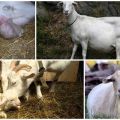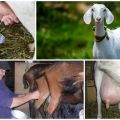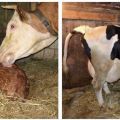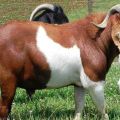How and for how much it is correct to run a goat before lambing, life hacks and problems
Wild goats were among the first to be domesticated. This happened much earlier than cows and sheep became domesticated. For humans, domestic goats have become a source of healthy milk. A small animal does not require too much food and is unpretentious. It is not difficult to contain it, but you need to know some features of physiology. Not all goat owners know how to properly start a domestic goat before lambing and how many days it needs to be done.
What does it mean?
A good dairy queen can fully provide an average static family of 4 with healthy milk and dairy products. Milk in these animals appears after lambing and, first of all, is intended for a newborn kid. Many have heard the expression "run the goat", but not all novice goat breeders can correctly interpret this term.
The launch of any dairy animal is a rest period from milking a pregnant or succumbing female to the birth of offspring. If this process is carried out correctly and in a timely manner, then the milk yield after childbirth will be quite large, and the goat's milk will give good quality.
Goat start time
At the end of pregnancy, many queens have less milk. Approximately one and a half to two months before lambing, lactation subsides, and the pregnant female completely stops giving milk. In this case, we can say that the animal coped without human help. This phenomenon is very common in multiple pregnancies.
However, most queens require the help of a host to stop milk production. This is especially true of productive animals that provide milk until birth. In this case, the owner of the animal must correctly determine the launch time.

The average duration of pregnancy in domestic goats is 150 days or 5 months. In its second half, intensive fetal growth begins. Sometimes the launch of the uterus is carried out at the very end, when the gestational age is 4 months. But in most cases, experienced owners of these animals advise launching a little earlier. After all, a timely launch is the key to the health of the female, offspring and further good lactation.
How to properly launch an animal
Often a pregnant female gives milk throughout the entire period. In this case, some tricks and life hacks from experienced goat owners will help to stop lactation. They advise, first of all, to keep pregnant queens separately from the rest of the livestock.If the suckiness fell on the grazing period, then knowledgeable goat breeders recommend reducing the grazing time to 3-4 hours a day or, if possible, stop it altogether.
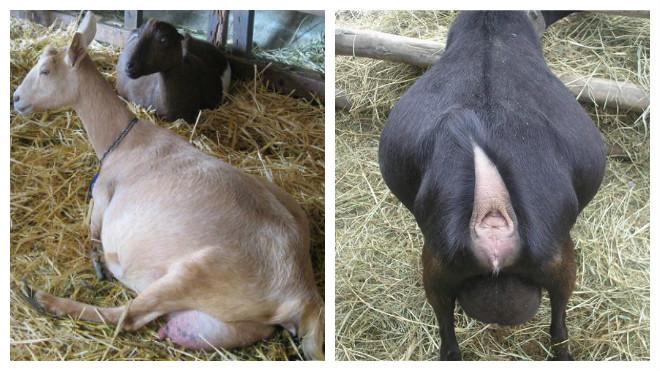
The next step is to adjust the diet:
- first, reduce the amount of juicy feed, then abandon them altogether;
- do not give fresh green grass;
- remove grain, grain mixtures, crackers;
- do not feed with silage;
- exclude compound feed;
- remove the tops of vegetable crops;
- refuse warm swill with the addition of bran;
- do not give premixes such as "Zinki", "Felucena".
The diet of succumb animals mainly consists of dry feed with low nutritional value. They are fed:
- hay, including legumes or cereals;
- birch or linden brooms;
- barley straw;
- sunflower cake (meal).
With such feeding, pregnant uterus need to reduce the amount of fluid. The animal is given only clean water to drink. They do this at the same time of the day.
Simultaneously with the correction of the diet when starting the goats, the frequency of milking is reduced. As a rule, goats with a fairly high capacity for lactation are milked both in the evening and in the morning. The periods between milkings are 12 hours. 3-4 days after the transfer of the goat to a dry diet, the animal is milked only once a day.
Sometimes goats are milked three times a day every 7-8 hours. In this case, they first switch to two-time milking after 12 hours, and then to one-time milking. The interval between milkings is increased gradually, increasing it by an hour or two every day.
If the animal cannot withstand such a period without milking, the udder swells and hardens greatly, then milking is carried out more often, after about 16-17 hours.
Within a few days of this milking, milk production begins to decrease. As soon as the goat in the starting state starts giving no more than 150-200 ml of milk per day, milking is stopped. During this period, you need to monitor the condition of the udder. If it is mild, then there is no cause for concern.
General indicators of lactation when starting a goat are shown in the table.
| Period from the start of the launch | Number of milkings | Amount of milk, liters |
| One week | Once every 24 hours | 1,0-1,2 |
| Two weeks | 1 time in 36 hours | 0,6-0,8 |
| Three weeks | Once every 48 hours | 0,3-0,5 |
| Four weeks | If necessary | 0,2 |

Thus, if you start the launch at a period of two and a half months, then lactation will end about a month and a half before lambing, and the goat will have time to prepare for childbirth.
What to feed after the process
Approximately 10-11 days after the last milking, the uterus needs to change the diet again. As a rule, she is fed according to the same scheme as before launch, gradually increasing the amount of the feed that was given to her before launch. Restrictions are needed only for juicy feed. As a rule, they are given to the queens about two to three times less.
All feed must be of high quality. Root crops and vegetables must be washed well before feeding. They should be free of rot, mold, soil. During this period, the goat should not be fed with straw. It has low nutritional value and is not useful for future offspring, it only clogs the stomach of the uterus. The proportion of feed that can cause fermentation and excessive gassing is also reduced or eliminated altogether. During this period, you can pamper the goat with boiled potatoes, crackers.
Possible problems
Despite all the efforts of man, there are goats that cannot be started by any measures and techniques. Usually these are young animals in the first few lambings. This is due to the fact that they manage to be covered twice a year. The situation with such goats improves when they turn 5-6 years old. Even if such a queen is covered a second time, then it can be launched during spring lambing.
An incorrectly conducted launch threatens the animal with the development of mastitis.Therefore, the state of the goat udder after the last milking during the start-up period should be checked every 1-2 days. If after 2-3 days the udder has poured and hardened, then the milk must be carefully expressed. They do this very carefully, lightly touching only the nipples with their fingers. Even light massaging and stroking of the udder provokes an increase in lactation.
During the start-up period, the goat is milked without prior preparation. The udder is not massaged, and the goat is not spoken to. Milk quickly, without showing undue attention. Any tenderness and stimulation of the udder prolongs the start-up period.
Very often, with improper feeding after starting, the uterus can fall to its feet. This is due to impaired calcium metabolism. It causes joint weakness not only in goats, but also in newborn kids. They do not rise on their legs for a long time and do not hold well on them. Such a pathology affects animals whose diet before giving birth was too much succulent feed.
